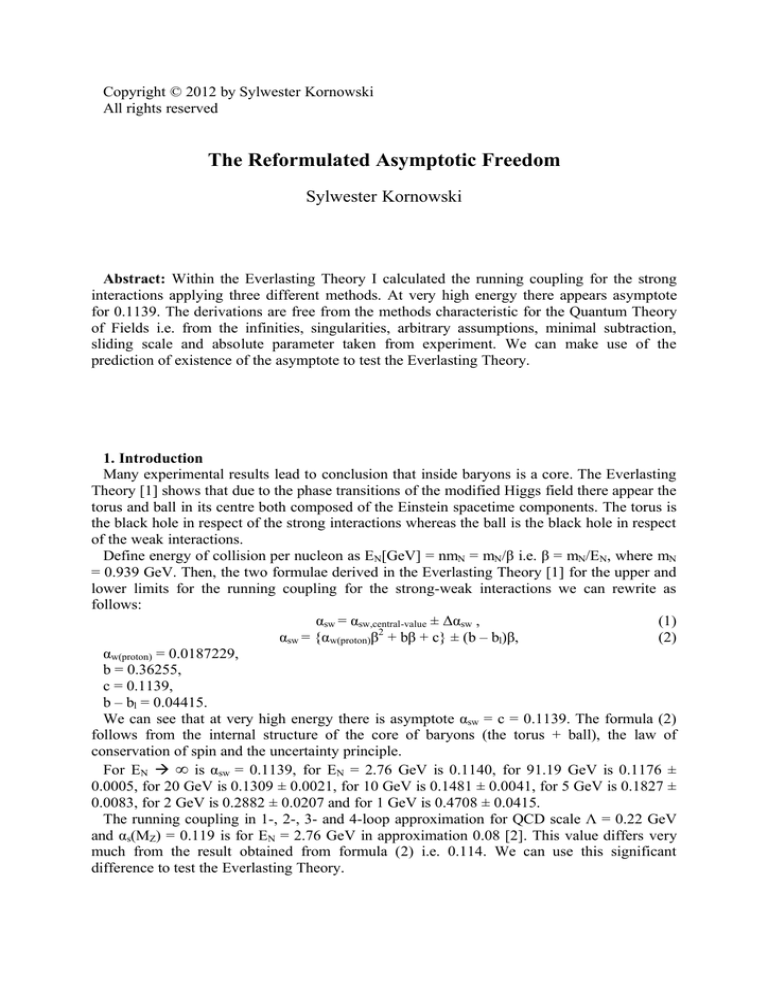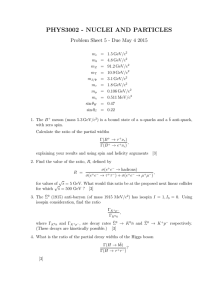
Copyright © 2012 by Sylwester Kornowski
All rights reserved
The Reformulated Asymptotic Freedom
Sylwester Kornowski
Abstract: Within the Everlasting Theory I calculated the running coupling for the strong
interactions applying three different methods. At very high energy there appears asymptote
for 0.1139. The derivations are free from the methods characteristic for the Quantum Theory
of Fields i.e. from the infinities, singularities, arbitrary assumptions, minimal subtraction,
sliding scale and absolute parameter taken from experiment. We can make use of the
prediction of existence of the asymptote to test the Everlasting Theory.
1. Introduction
Many experimental results lead to conclusion that inside baryons is a core. The Everlasting
Theory [1] shows that due to the phase transitions of the modified Higgs field there appear the
torus and ball in its centre both composed of the Einstein spacetime components. The torus is
the black hole in respect of the strong interactions whereas the ball is the black hole in respect
of the weak interactions.
Define energy of collision per nucleon as EN[GeV] = nmN = mN/β i.e. β = mN/EN, where mN
= 0.939 GeV. Then, the two formulae derived in the Everlasting Theory [1] for the upper and
lower limits for the running coupling for the strong-weak interactions we can rewrite as
follows:
αsw = αsw,central-value ± Δαsw ,
(1)
αsw = {αw(proton)β2 + bβ + c} ± (b – bl)β,
(2)
αw(proton) = 0.0187229,
b = 0.36255,
c = 0.1139,
b – bl = 0.04415.
We can see that at very high energy there is asymptote αsw = c = 0.1139. The formula (2)
follows from the internal structure of the core of baryons (the torus + ball), the law of
conservation of spin and the uncertainty principle.
For EN ∞ is αsw = 0.1139, for EN = 2.76 GeV is 0.1140, for 91.19 GeV is 0.1176 ±
0.0005, for 20 GeV is 0.1309 ± 0.0021, for 10 GeV is 0.1481 ± 0.0041, for 5 GeV is 0.1827 ±
0.0083, for 2 GeV is 0.2882 ± 0.0207 and for 1 GeV is 0.4708 ± 0.0415.
The running coupling in 1-, 2-, 3- and 4-loop approximation for QCD scale Λ = 0.22 GeV
and αs(MZ) = 0.119 is for EN = 2.76 GeV in approximation 0.08 [2]. This value differs very
much from the result obtained from formula (2) i.e. 0.114. We can use this significant
difference to test the Everlasting Theory.
2
2. Calculations
On surface of the torus inside the core of baryons appear the gluon balls. Their energy
M[GeV] we can calculate from formulae (214)-(216) presented here [1]. We can rewrite these
formulae as follows
M[GeV] = (C/EN[GeV] + D)10,
(3)
C = 0.52294,
D = 0.96868.
Calculate following derivative ∂M/∂EN
∂M/∂EN = – 10C(C/EN + D)9/EN2,
(4)
For C/EN << D i.e. for EN >>C/D = 0.54, we obtain
∂M/∂EN = – F/EN2,
(5)
F = 3.927.
The value F is for the strongly interacting torus which mass is X = 318.3 MeV [1]. This
torus produces gluons which energy mg is the one fourth of the mass of the bound neutral pion
(134.9661 MeV) [1]. The change of the X onto mg changes the value of the F: F’ = Fmg/X ≈
0.42. So, we can rewrite the formula (5) as follows
∂M/∂EN = – F’/EN2,
(6)
F’ = 0.42.
Integrate the equation (6). There appears the integration constant H which we can interpret
as the ratio of the mass of the torus X to the mass of nucleon mN : H = X/mN. We obtain
M = F’/EN + H,
(7)
H = 0.339.
We can define running coupling αsw as follows αsw = M2. It leads to following formula
αsw = (F’/EN + H)2,
(8)
For EN ∞ is αsw = 0.115, for EN = 2.76 GeV is 0.115, for 91.19 GeV is 0.118, for 20 GeV
is 0.13, for 10 GeV is 0.15, for 5 GeV is 0.18, for 2 GeV is 0.30 and for 1 GeV is 0.58. We
can see that only for 1 GeV the obtained result from formula (8) is not close to the central
value obtained from formula (2).
The formula (8) we can derive in different way. The gluon balls produced from the energy
of collision of a nucleon look similarly to the ball in the centre of torus. Due to the
confinement [1], the all gluon balls have the same radius as the ball in centre of torus. When
energy of a gluon ball increases then increases the rotational energy of the carriers of the
gluons the ball consists of. This energy does not increase mass density of the ball so it still is
the black hole in respect of the weak interactions. For a rotating gluon ball is Eb v r = const.
i.e. Eb ~ 1/v, where v is the spin speed of the rotating components of the Einstein spacetime
i.e. the carriers of gluons. The relative mass Rsw responsible for asymptotic freedom, we can
separate into two parts. The first part concerns the strong interactions of the torus that is the
black hole in respect of the strong interactions. The R_strong should be R_strong = X/mN,
where X = 0.3183 GeV is the rest mass of the torus. The second part concerns the weak
interactions of the created gluon balls. They are the black holes in respect of the weak
interactions. Due to the relation Eb ~ 1/v, the intensity of weak interactions of the gluon balls
decreases when energy increases. It leads to conclusion that the second part R_weak should
be R_weak = Y/EN, where Y = 0.4241 GeV is the rest mass of the ball in centre of the torus.
The above description leads to following formula
Rsw = R_weak + R_strong = Y/EN + X/mN.
(9)
2
Similar as previously we can define the running coupling as R so we obtain
αsw = (Y/EN + X/mN)2.
(10)
This formula is correct for EN >> Eo = YmN/X = 1.25 GeV. Due to the quadrupole
symmetry for the weak interactions, the lower limit for the EN should be 4Eo = 5 GeV and
such value is in the old asymptotic freedom.
3
3. Summary
I described the asymptotic freedom applying three different methods. They lead to the same
or very close theoretical results. The theoretical results are consistent or very close to
experimental data. This means that experimental results lead to the core of baryons composed
of the torus and ball in its centre. Within the Everlasting Theory I derived the internal
structure of the core of baryons on base of the phase transitions of the modified Higgs field
which I refer to as the Newtonian spacetime. This spacetime consists of internally
structureless tachyons that carry the inertial mass only. The modified Higgs field is
gravitationally the massless field. Moreover, the mean spin of the tachyons is in
approximation 1067 times lower than the reduced Planck constant so the modified Higgs field
is practically the scalar field.
The old QCD [3], [4] should be inconsistent with experimental data at very high energies. It
follows from the fact that the Quantum Theory of Fields neglects the internal structure of the
bare fermions (i.e. the torus + ball) and neglects the atom-like structure of baryons [1].
I described the origin of the mass scale 5 GeV which appears in the old asymptotic freedom.
The new asymptotic freedom is free from the methods characteristic for the Quantum
Theory of Fields i.e. from the infinities, singularities, arbitrary assumptions, minimal
subtraction, sliding scale and absolute parameter taken from experiment.
We can make use of the prediction of existence of the asymptote 0.1139 to test the
Everlasting Theory.
References
[1] S. Kornowski (2012). “The Everlasting Theory and Special Number Theory”.
http://www.rxiv.org/abs/1203.0021 [v2].
[2] S. Bethke (2008). “Experimental Tests of Asymptotic Freedom”.
http://arxiv.org/pdf/hep-ex/0606035v2.pdf , p. 12.
[3] D.J. Gross, F. Wilczek (1973). “Ultraviolet behaviour of non-abelian gauge theories”.
Physical Review Letters 30 (26).
[4] H.D. Politzer (1973). “Reliable perturbative results for strong interactions”. Physical
Review Letters 30 (26).





